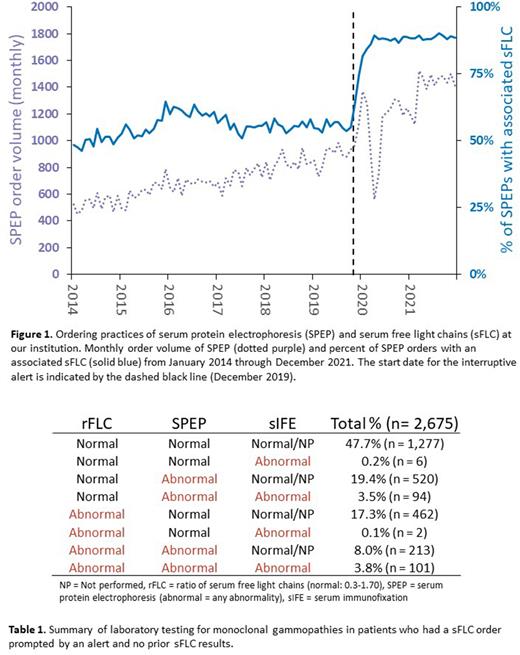Abstract
Introduction: Since its introduction in 2001, the serum free light chain (sFLC) assay has played an increasingly prominent role in the initial clinical evaluation of patients with suspected monoclonal gammopathies (MGs). This is primarily due to its superior sensitivity for detecting monoclonal proteins especially in light chain disease. In 2009, the International Myeloma Working Group (IMWG) recommended ordering the combination of an SPEP, sFLC and sIFE for initial screening for all MGs. However, there is still significant heterogeneity in sFLC ordering practices. A recent survey of over 700 clinical laboratories found that sFLC were included in the most common screening order sets for the initial evaluation of MGs in only 19.7% of centers.
Methods: We performed a retrospective analysis of SPEP and sFLC ordering practices at our institution over a 6-year period (2014-2019). We then designed and implemented a clinical decision support (CDS) alert to improve compliance with IMWG's recommendations. The alert fires when a provider orders an SPEP without a concurrent sFLC order or result in the last 30 days and suggests the ordering of sFLC. We analyzed the impact on ordering practices and diagnostic outcomes over the course of a 10-month period.
Results: Our retrospective analysis of over 90,000 SPEP results, associated sFLC orders, and ICD-10 codes revealed that many providers deviated from society guidelines for the use of sFLC in the initial laboratory evaluation of MGs. Prior to the alert 62.8% of all SPEP evaluations included sFLC testing, while post-implementation nearly 90% of evaluations included sFLC (Figure 1). When restricting our analysis to patients with no prior sFLC results, we found that the alert contributed to the clinical care of as many as 2,791 patients. Twenty nine percent (810/2,791) of these patients had an abnormal kappa/lambda ratio (rFLC). In 462 of these patients the rFLC was the only laboratory evidence of a monoclonal protein (Table 1). Moreover, within this population there were numerous instances of new diagnoses of multiple myeloma and other MGs.
Conclusions: In the initial laboratory evaluation of MGs, a CDS alert was an effective tool to increase clinical practice compliance with society guidelines. More importantly, the alert prompted sFLC orders that contributed to the diagnosis of numerous MGs that may have been missed or warrant further investigation and follow up. This study will hopefully serve as a useful guide for other institutions addressing the gap between clinical practice and evidence-based guidelines.
Disclosures
No relevant conflicts of interest to declare.
Author notes
Asterisk with author names denotes non-ASH members.


This feature is available to Subscribers Only
Sign In or Create an Account Close Modal